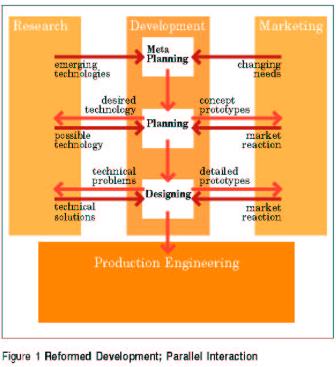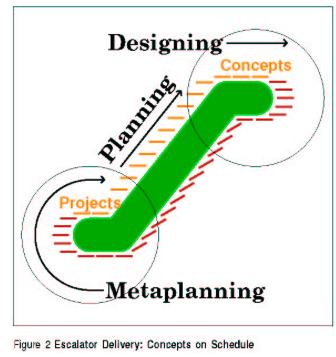Like so many other things, development (as in R&D) will have to be rethought over and over again as we move deeper into the new century. More people, more markets, more competition; new technologies, new aspirations, new opportunities – nothing is stable for very long anymore.
For a company or, for that matter, a lot of other organizations, staying up with the competition will more and more be a matter of achieving integrity (see the Innovation article Another Look at Quality). And not a little of that will involve developing fresh, intriguing, dominating concepts at a pace considered pretty fast today.
In First Things First, I strongly advocated the division of the development process into two distinct components. This allows concentration on concept – what the product is – before committing to all of the details that must be invented, designed and approved in moving from concept to specification. A two-step development process permits serious exploration of possibilities unlikely to be considered if the concept is already a “given” at the beginning of the process.
Metaplanning
Not unexpectedly, acceptance of a two-step development process leads to specialization of the methods used for planning and designing. For the designing part of the process, a number of methods have been introduced and refined in recent years. The recognition that major improvements can be made to products and services of all kinds by paying more attention to users – through user-centered design – has led to a renaissance in design methodology and a flowering of design research worldwide.
Similar interest has developed in methodology specialized for work at the planning level – Structured Planning is an example. And as in-depth attention to planning and design has grown, the development of new tools has accelerated. The growing ease with which planners and designers now embrace computer-supported methods is fueling the same kind of accelerated development of software seen in other fields, and that has precipitated another interesting organizational evolution: the appearance of a “metaplanning” function in the chain of development.
For a producer at the front of the change curve, change is not restricted to the products. Change is a permanent part of the process as well. Driving the evolution of metaplanning in development is the need to stay abreast of new methods and tools. Acquiring and evaluating them as they appear, adapting them to the special needs of the organization, learning how to use them, and training others who will apply them has become a full-time job. Companies aware of this are reflecting it in their organization structures: by defining a group or department committed to the acquisition, maintenance, customization and communication of planning and design methods and tools – Metaplanning.
Given a commitment of human resources, it is only a short conceptual step to implementing the complementary functions implicitly called for in a metaplanning activity. Planning is done by teams, and the teams will need resources, schedules, a planning process, training and a charge or charter. This is a logical role for Metaplanning, which can prepare ahead what is needed to launch and support the planning teams.
The planning process will be custom fit to the needs of the organization and the availability of new tools – the defining justification for the metaplanning function in the first place. The need for establishing the charge opens another need/opportunity for change. Depending on the temporal distance a development activity is from the reality of manufacturing engineering (or its equivalent in service-creating organizations), its role will be more involved (when close) or less involved (when far) with product specifics. At the maximum distance, where metaplanning exists, the level of abstraction is greatest; metaplanning is the process of planning the process.
This concept is sometimes a bit hard to grasp. For me, it is easiest to explain by working backward through the development process. I am working presently with the City of Chicago to help the city prepare for climate change. Our problem at this stage is very much a metaplanning problem, and it can be understood nicely by thinking about what we might see in a hypothetical city already prepared for the climate and weather extremes to be expected as climate change takes hold. In the hypothetical city, we would see local mitigating actions being taken – such as permeable paving surfaces being installed to absorb rainwater runoff and rooftop gardens being planted to cool buildings – preparing the city infrastructure for the effects of intense storms, heat waves, power outages, drought and other weather events. We would also see organizations, installations and response mechanisms in place to react during the events to the human tragedies and property damage still unavoidable, and we would find plans for post-event restoration as well as feedback for improving future responses. All these would be implementations – the results of a thorough designing effort in the final phase of development.
Backing up, the designing phase would have followed from a planning phase that would have identified the threats most likely for the city and assembled ideas as system concepts appropriately plannedto take best advantage of the city’s resources. Backing up again, the creation of the planning process would have been the job of metaplanning. Establishing how information on threats and possible adaptations would be assembled, distilled into usable form, structured to reveal relationships, and processed into policy directing the course of implementation would be the metaplanning task.
For the corporation, the problem is similar – except that there is competition and, therefore, the need for continuing metaplanning as well as planning and designing. This mandates a reorganization of the development function with three distinct functional phases (Figure 1).

(Figure 1 Reformed Development; Parallel Interaction)
Reforming Development
Implementing a reformed development process creates a much more agile advanced planning system able to seize opportunities almost before they appear. Figure 1 diagrams the organization in the context of strongly associated Research and Marketing functions made substantially more effective by new possibilities for relationship with Development.
The new agility is immediately evident. Whereas before, Research and Development were more likely to be organized sequentially, in the new model they operate in parallel with different relationships at different stages – aligned with the three levels of development: Metaplanning, Planning, and Designing. At the Metaplanning level, the Research/Development relationship is concerned with emerging technologies – technologies that the company may wish to investigate, develop or acquire. Research staff will be actively probing basic and applied research around the globe as it might have long-term potential for the company. Metaplanning Development staff will be asking “what if” questions by specifying the exploration of promising technologies in new-concept planning projects.
Similar high level activity in Marketing will seek out changing trends in society at home and abroad that could lead to promising new product opportunities. Marketing staff will work at the level of conference attendance, journal article analysis, and support of joint ventures in social science research. Development staff will unite the uncovered trends with emerging technologies in the planning projects being composed.
At the level of Planning in Development, Research staff will be concerned with matching functionality desired by planning teams with technologies attainable in-house or available from outside sources. Where appropriate, in-house technology being developed can be directed toward evolving concepts. In Marketing, concept prototypes from Planning will be market tested for appeal and feature approval.
Finally, at the level of Designing, the more conventional relationships between Research, Development and Marketing will surface. Solutions to technical problems beyond design engineering are the responsibility of Research, and market reactions to the subtleties of detailed prototypes are the business of Marketing.
Escalator Delivery
The reformed development process smoothes the way for one more very useful process extension. I call it escalator delivery (Figure 2).
In an ideal world, management would have at hand whenever needed highly promising concepts to be carried through detailed design into production. With escalator delivery, this becomes a real possibility. If the conduct of planning projects need not be restricted to a single designated group or team, it is possible to create a delivery system geared to any desired frequency of concept generation.
For escalator delivery, multiple planning teams are assembled as needed from a mix of departments expected to be involved with the new product. Each team is led by a team member who has been through the planning process before. Prepared and supported by Metaplanning, each team explores its charter, develops a fully considered concept, and then disbands with members returning to home departments.

Projects are initiated at a frequency that matches the frequency at which new concepts are desired. Whatever the planning time allocated, once the first project is completed, succeeding projects follow at the desired delivery frequency. The escalator is as long as the planning process; steps (projects) are as close together as the desired frequency of completion. Given a sound planning process, escalator delivery practically guarantees reliable, high-quality concepts at a predictable rate of appearance.
The concept has additional benefits:
As teams complete their work, team members returning to their departments become champions of the project as those most knowledgeable about the “what’s” and “why’s” of its development.
In going through the planning process, those employees have also received hands-on training in what it takes to develop a concept. In the process of conducting the project, they have learned how insights are transformed to ideas and integrated into workable product concepts― preparation enabling them to continue as active information contributors from within their departments. If the planning process is backed with a well-structured and formatted knowledge base, they will be able to continue to contribute to it and help others to do the same. The suggestion box never was so good.
The value is multiplied if the knowledge base is qualitative. Companies and other organizations lose untold amounts of valuable information every year through the loss of personnel to retirement, resignation and transfer. A strong qualitative knowledge base can preserve the “why” reasons for actions – the insights that disappear with the departure of those knowledgeable about the actions.A strong planning process provides the knowledge base for saving the “why’s”; escalator delivery creates a growing body of employees with the training to know how and why to use it.

















